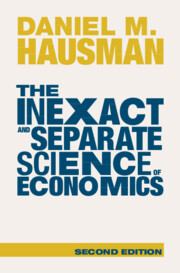Book contents
- The Inexact and Separate Science of Economics
- The Inexact and Separate Science of Economics
- Copyright page
- Contents
- Figures
- Tables
- Introduction
- Part I Introduction: Content, Structure, and Strategy of Mainstream Economics
- 1 Rationality, Preferences, and Utility Theory
- 2 Demand and Consumer Choice
- 3 The Theory of the Firm and General Equilibrium
- 4 Equilibrium Theory and Normative Economics
- 5 Equilibrium Theory and Macroeconomic Models
- 6 Models and Theories in Economics
- 7 The Structure and Strategy of Economics
- 8 Overlapping Generations
- Part II Theory Assessment
- Part III Conclusion
- Appendix An Introduction to Philosophy of Science
- References
- Index
6 - Models and Theories in Economics
from Part I - Introduction: Content, Structure, and Strategy of Mainstream Economics
Published online by Cambridge University Press: 25 May 2023
- The Inexact and Separate Science of Economics
- The Inexact and Separate Science of Economics
- Copyright page
- Contents
- Figures
- Tables
- Introduction
- Part I Introduction: Content, Structure, and Strategy of Mainstream Economics
- 1 Rationality, Preferences, and Utility Theory
- 2 Demand and Consumer Choice
- 3 The Theory of the Firm and General Equilibrium
- 4 Equilibrium Theory and Normative Economics
- 5 Equilibrium Theory and Macroeconomic Models
- 6 Models and Theories in Economics
- 7 The Structure and Strategy of Economics
- 8 Overlapping Generations
- Part II Theory Assessment
- Part III Conclusion
- Appendix An Introduction to Philosophy of Science
- References
- Index
Summary
Chapter 6 is concerned with theories and models in economics. Economists typically prefer to speak of “models” rather than “theories” and of “generalizations” or “assumptions” rather than “laws.” Economists still speak of theories, but only when referring to subdivisions of the discipline. Why? What are models and how are they related to theories? Why are economists so enamored of models? Do they supersede or incorporate laws? Without settled definitions of theories or models, it is unclear whether the focus on models is just a change in terminology, or whether there is something interestingly different in the practice of contemporary economics. This chapter surveys philosophical conceptions of theories and defends a view of theories as sets of lawlike statements that are systematically interconnected. It argues that models should be understood as conceptual explorations without empirical commitments. They are definitions of predicates or kinds of systems. Models can be used to theorize, explain, or predict, when one offers theoretical hypotheses asserting that parts of the real world belong to the extension of the predicate a model defines.
Keywords
- Type
- Chapter
- Information
- The Inexact and Separate Science of Economics , pp. 154 - 183Publisher: Cambridge University PressPrint publication year: 2023



